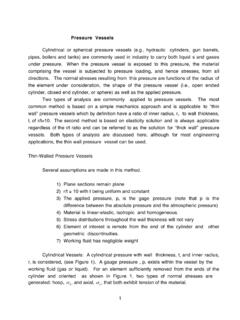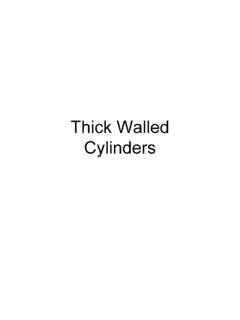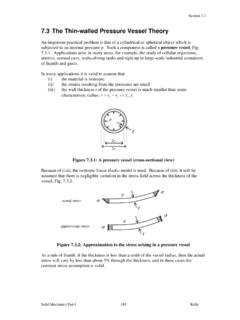Transcription of NOTE L - MIT OpenCourseWare
1 DEPARMENT OF NUCLEAR ENGINEERING MASSACHUSETTS INSTITUTE OF TECHNOLOGY NOTE INTRODUCTION TO STRUCTURAL MECHANICS Lothar Wolf*, Mujid S. Kazimi** and Neil E. Todreas Nominal Load Point 35 55 6569 100 1 -25 Max theory DE theory Limiting PointsMohr theory Max theory -45 -60 Load Line -100 Shear Diagonal 2 * Professor of Nuclear Engineering (retired), University of Maryland ** TEPCO Professor of Nuclear Engineering, Massachusetts Institute of Technology KEPCO Professor of Nuclear Engineering, Massachusetts Institute of Technology Rev 12/23/03 ENGINEERING OF NUCLEAR REACTORS Fall 2003 NOTE INTRODUCTION TO STRUCTURAL MECHANICS L. Wolf Revised by Kazimi and Todreas 1979, 1993, 1994, 1995, 1996, 1998, 2000, 2003 12/23/03 TABLE OF CONTENTS Page 1. Definition of 1 Concept of State of Stress .. 4 Principal Stresses, Planes and Directions .. 6 Basic Considerations of 6 Plane Stress .. 8 Mohr s Octahedral Planes and Principal Strains and 2.
2 Elastic Stress-Strain Relations ..17 Generalized Hooke s Modulus of Volume Expansion (Bulk Modulus) ..19 3. Thin-Walled Cylinders and Stresses ..21 Deformation and Strains ..22 End Effects for the Closed-Ended Cylinder ..24 4. Thick-Walled Cylinder under Radial Displacement Stress 5. Thermal Stress Boundary Final 6. Design Procedures ..37 Static Failure and Failure Prediction of Failure under Biaxial and Triaxial Maximum Normal-Stress Theory (Rankine) ..41 Maximum Shear Stress Theory (The Coulomb, later Tresca Theory)..44 Mohr Theory and Internal-Friction Maximum Normal-Strain Theory (Saint-Varants Theory)..47 Total Strain-Energy Theory (Beltrami Theory)..48 Maximum Distortion-Energy Theory (Maximum Octahedral-Shear-Stress Theory, Van Mises, Hencky) ..49 i TABLE OF CONTENTS (continued) Page Comparison of Failure Application of Failure Theories to Thick-Walled Prediction of Failure of Closed-Ended Circular Cylinder Thin-Walled Pressure Examples for the Calculation of Safety Factors in Thin-Walled References.
3 61 ii INTRODUCTION TO STRUCTURAL MECHANICS M. S. Kazimi, Todreas and L. Wolf 1. DEFINITION OF CONCEPTS Structural mechanics is the body of knowledge describing the relations between external forces, internal forces and deformation of structural materials. It is therefore necessary to clarify the various terms that are commonly used to describe these quantities. In large part, structural mechanics refers to solid mechanics because a solid is the only form of matter that can sustain loads parallel to the surface. However, some considerations of fluid-like behavior (creep) are also part of structural mechanics. Forces are vector quantities, thus having direction and magnitude. They have special names (Fig. 1) depending upon their relationship to a reference plane: a) Compressive forces act normal and into the plane; b) Tensile forces act normal and out of the plane; and c) Shear forces act parallel to the plane. Pairs of oppositely directed forces produce twisting effects called moments.
4 Y x z y x z y x z Compressive Tensile Shear Figure 1. Definition of Forces. Note Page 2 The mathematics of stress analysis requires the definition of coordinate systems. Fig. 2 illustrates a right-handed system of rectangular coordinates. y x z z y x x z y Figure 2. Right-handed System of Rectangular Coordinates. In the general case, a body as shown in Fig. 3 consisting of an isolated group of particles will be acted upon by both external or surface forces, and internal or body forces (gravity, centrifugal, magnetic attractions, etc.) If the surface and body forces are in balance, the body is in static equilibrium. If not, accelerations will be present, giving rise to inertia forces. By D Alembert s principle, the resultant of these inertial forces is such that when added to the original system, the equation of equilibrium is satisfied. The system of particles of Fig. 3 is said to be in equilibrium if every one of its constitutive particles is in equilibrium.
5 Consequently, the resulting force on each particle is zero, and hence the vector sum of all the forces shown in Fig. 3 is zero. Finally, since we observe that the internal forces occur in self-canceling pairs, the first necessary condition for equilibrium becomes that the vector sum of the external forces must be zero. F F F n 1 2 Figure 3. An Isolated System of Particles Showing External and Internal Forces (Ref. 1, Fig ). Note Page 3 F1 + F2 + .. + Fn = Fn = 0 ( ) nThe total moment of all the forces in Fig. 3 about an arbitrary point 0 must be zero since the vector sum of forces acting on each particle is zero. Again, observe that internal forces occur in self-canceling pairs along the same line of action. This leads to the second condition for equilibrium: the total moment of all the external forces about an arbitrary point 0 must be zero. r1F1 + r2F2 + .. + rnFn = rnFn = 0 ( ) nwhere rn extends from point 0 to an arbitrary point on the line of action of force Fn.
6 In Fig. 4A, an arbitrary plane, aa, divides a body in equilibrium into regions I and II. Since the force acting upon the entire body is in equilibrium, the forces acting on part I alone must be in equilibrium. In general, the equilibrium of part I will require the presence of forces acting on plane aa. These internal forces applied to part I by part II are distributed continuously over the cut surface, but, in general, will vary over the surface in both direction and intensity. dF I II I a a dAa a Point 0 Point 0 n AB Figure 4. Examination of Internal Forces of a Body in Equilibrium. Stress is the term used to define the intensity and direction of the internal forces acting at a particular point on a given plane. Metals are composed of grains of material having directional and boundary characteristics. However, these grains are usually microscopic and when a larger portion of the material is considered, these random variations average out to produce a macroscopically uniform material.
7 Macroscopic uniformity = homogenous, If there are no macroscopic direction properties the material is isotropic. Note Page 4 Definition of Stress (mathematically), (Fig. 4B) [see Ref. 1, p. 203] n rT = stress at point 0 on plane aa whose normal is n passing through point 0 = lim dF where dF is a force acting on area 0 n T to introduce the concept that n [Reference 1 uses the notation T is a stress vector] NOTE: Stress is a point value. The stress acting at a point on a specific plane is a vector. Its direction is the limiting direction of force dF as area dA approaches zero. It is customary to resolve the stress vector into two components whose scalar magnitudes are: normal stress component : acting perpendicular to the plane shear stress component : acting in the plane. Concept of State of Stress The selection of different cutting planes through point 0 would, in general, result in stresses differing in both direction and magnitude.
8 Stress is thus a second-order tensor quantity, because not only are magnitude and direction involved but also the orientation of the plane on which the stress acts is involved. NOTE: A complete description of the magnitudes and directions of stresses on all possible planes through point 0 constitutes the state of stress at point 0. NOTE: A knowledge of maximum stresses alone is not always sufficient to provide the best evaluation of the strength of a member. The orientation of these stresses is also important. In general, the overall stress state must be determined first and the maximum stress values derived from this information. The state of stress at a point can normally be determined by computing the stresses acting on certain conveniently oriented planes passing through the point of interest. Stresses acting on any other planes can then be determined by means of simple, standardized analytical or graphical methods. Therefore, it is convenient to consider the three mutually perpendicular planes as faces of a cube of infinitesimal size which surround the point at which the stress state is to be determined.
9 Figure 5 illustrates the general state of 3D stress at an arbitrary point by illustrating the stress components on the faces of an infinitesimal cubic element around the point. Note Page 5 Infinitesimal Cube about Point of Interest y yx y yz 0x P zy zx z xyz x xz Figure 5. Stress Element Showing General State of 3D Stress at a Point Located Away from the Origin. Notation Convention for Fig. 5: Normal stresses are designated by a single subscript corresponding to the outward drawn normal to the plane that it acts upon. The rationale behind the double-subscript notation for shear stresses is that the first designates the plane of the face and the second the direction of the stress. The plane of the face is represented by the axis which is normal to it, instead of the two perpendicular axes lying in the plane. Stress components are positive when a positively-directed force component acts on a positive face or a negatively-directed force component acts on a negative face.
10 When a positively-directed force component acts on a negative face or a negatively-directed force component acts on a positive face, the resulting stress component will be negative. A face is positive when its outwardly-directed normal vector points in the direction of the positive coordinate axis (Ref. 1, pp. 206-207). All stresses shown in Fig. 5 are positive. Normal stresses are positive for tensile stress and negative for compressive stress. Figure 6 illustrates positive and negative shear stresses. NOTE: yx equals xy. y - yx Figure 6. Definition of Positive and Negative yx.+ yx xz Note Page 6 Writing the state of stress as tensor S: x xy xz S = 9-components ( ) zx zy z yx y yz However, we have three equal pairs of shear stress: xy = yx, xz = zx, yz = zy ( ) Therefore, six quantities are sufficient to describe the stresses acting on the coordinate planes through a point, , the triaxial state of stress at a point.



















